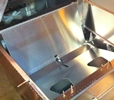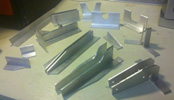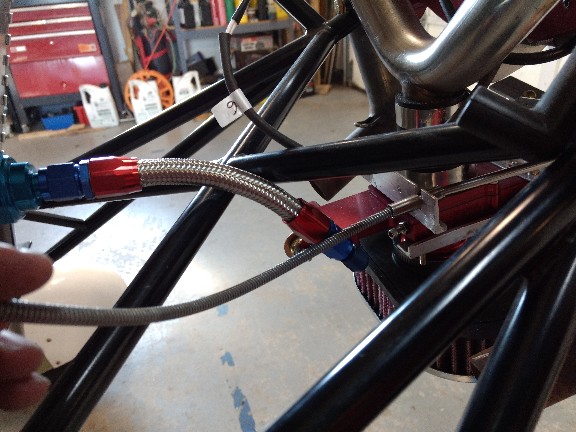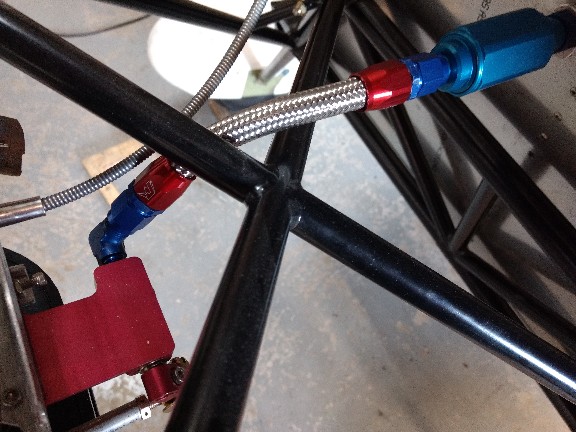


random user submitted photo
no fuel filter
12 posts
• Page 1 of 2 • 1, 2
no fuel filter
Anyone not using a fuel filter? I have one now but it's such a short run. I have all fittings on there which doesn't leave much for any flexing in the line. Not having the filter would be so much easier. Thoughts?
John
John
- Johns
- Posts: 146
- Joined: Sun Jul 14, 2013 4:32 pm
Re: no fuel filter
I have a super-short run and a filter:


It is an inline filter:
https://www.jegs.com/i/JEGS/555/15034/10002/-1
From this area of my thread:
viewtopic.php?f=39&t=578&start=1010
Edit: There is two layers of firesleeve hiding that nice short installation now.
It is an inline filter:
https://www.jegs.com/i/JEGS/555/15034/10002/-1
From this area of my thread:
viewtopic.php?f=39&t=578&start=1010
Edit: There is two layers of firesleeve hiding that nice short installation now.
Bryan Cotton
Poplar Grove, IL C77
Waiex 191 N191YX
Taildragger, Aerovee, acro ailerons
dual sticks with sport trainer controls
Prebuilt spars and machined angle kit
Year 2 flying and approaching 200 hours December 23
Poplar Grove, IL C77
Waiex 191 N191YX
Taildragger, Aerovee, acro ailerons
dual sticks with sport trainer controls
Prebuilt spars and machined angle kit
Year 2 flying and approaching 200 hours December 23
-

Bryan Cotton - Posts: 5035
- Joined: Mon Jul 01, 2013 9:54 pm
- Location: C77
Re: no fuel filter
Pete Fernell doesn't use one on his plane. He explained that anything that would pass the finger strainer would also pass through his AeroCarb.
- karmarepair
- Posts: 160
- Joined: Sun Oct 11, 2020 8:13 pm
Re: no fuel filter
Bryan, that is the filter I am using. Thanks for the pics, gives me some ideas.
John
John
- Johns
- Posts: 146
- Joined: Sun Jul 14, 2013 4:32 pm
Re: no fuel filter
I was at sea. Dirt and water in fuel kills ships. Same for planes. SCRUPULOUSLY clean fuel is a mantra.
I'm not a fan of those inline filters. You have to break the system apart to inspect - which also means removing all the fireproof wrap. So you tend to not inspect.
But I think it is wishful thinking to believe an Aeroinjector will pass small amounts of dirt and water and keep working. At a minimum they are going to cause the engine to miss a bit - possibly at an inconvenient time. Or miss a lot - and stop.
The in tank finger strainer can't be inspected during a preflight. It might be quite clogged but you have no idea your fuel flow is reduced.
Back to.....A Gascolator! Which includes a filter. It is easily broken open to inspect the filter and when sampling for water - the speed the fuel fills the sample cup is a clue that the fuel flow is acceptable (or not).
--
There is a history of the gascolator causing vapor lock. Well - I fitted a high pass gascolator and have outside air pointed directly at the air filter to keep the engine running when you throttle back and have no air movement in the cowl after landing. No vapor lock issues.
I can check filtration by twisting the gascolator bowl off. I can check fuel flow when sampling.
I'm not a fan of those inline filters. You have to break the system apart to inspect - which also means removing all the fireproof wrap. So you tend to not inspect.
But I think it is wishful thinking to believe an Aeroinjector will pass small amounts of dirt and water and keep working. At a minimum they are going to cause the engine to miss a bit - possibly at an inconvenient time. Or miss a lot - and stop.
The in tank finger strainer can't be inspected during a preflight. It might be quite clogged but you have no idea your fuel flow is reduced.
Back to.....A Gascolator! Which includes a filter. It is easily broken open to inspect the filter and when sampling for water - the speed the fuel fills the sample cup is a clue that the fuel flow is acceptable (or not).
--
There is a history of the gascolator causing vapor lock. Well - I fitted a high pass gascolator and have outside air pointed directly at the air filter to keep the engine running when you throttle back and have no air movement in the cowl after landing. No vapor lock issues.
I can check filtration by twisting the gascolator bowl off. I can check fuel flow when sampling.
Graeme JW Smith
-

GraemeSmith - Posts: 939
- Joined: Sat May 18, 2019 8:58 am
- Location: RI
Re: no fuel filter
My advice;
Scrape the fancy wire braded fuel line - its just for looks, unnecessarily heavy and forget the screw/compression in line filters -high relative cost, prone to leakage and relatively heavy .
Put in a quality rubber fuel line (I use Gates FI) - you may need two convert to automotive style push on spigots (possibly right angle adapters to allow for slightly longer hose) and then fit a Hengst H102 (or 103) WK.
The Hengst filters are briliant - almost indestructible, clear casing for quick inspection, light weight, metal gauze filter (not nasty pleated "paper") and cheap enough to keep a spare or two in the aircraft and throw away used ones (I used compressed air to blow the old ones out & recycle them for ground based small engines). No guarantee but the design should catch small quantities of water (almost inevitable in aircraft fuel systems). I have been using them for 11 years in Rotax powered aircraft and much longer in Mercedes cars.
Scrape the fancy wire braded fuel line - its just for looks, unnecessarily heavy and forget the screw/compression in line filters -high relative cost, prone to leakage and relatively heavy .
Put in a quality rubber fuel line (I use Gates FI) - you may need two convert to automotive style push on spigots (possibly right angle adapters to allow for slightly longer hose) and then fit a Hengst H102 (or 103) WK.
The Hengst filters are briliant - almost indestructible, clear casing for quick inspection, light weight, metal gauze filter (not nasty pleated "paper") and cheap enough to keep a spare or two in the aircraft and throw away used ones (I used compressed air to blow the old ones out & recycle them for ground based small engines). No guarantee but the design should catch small quantities of water (almost inevitable in aircraft fuel systems). I have been using them for 11 years in Rotax powered aircraft and much longer in Mercedes cars.
- Skippydiesel
- Posts: 633
- Joined: Tue Jul 06, 2021 6:24 am
Re: no fuel filter
You must have something in front of the carby, tbi, or whatever.
I´m running an injected engine. There is no gascolator. There is a (very) fine filter protecting the injectors after the fuel pump battery, which has to be replaced every 200 hours, and a large capacity inline filter in front of the pumps. Between the inline and the pumps is the fuel drain plug. Remove the (safetied!) plug with the functioning inline filter in place, and the fuel starts flowing out- preferably in a suitably container. No fuel or just a little fuel flowing indicates a clogged inline filter- a Niagara indicates the inline is fit for fight.
The inline is cleaned every 25 hours- I´ve never seen anything close to clogging or flow reduction, but you´d be surprised how often I find one or two almost transparent grains of sand.
I´m running an injected engine. There is no gascolator. There is a (very) fine filter protecting the injectors after the fuel pump battery, which has to be replaced every 200 hours, and a large capacity inline filter in front of the pumps. Between the inline and the pumps is the fuel drain plug. Remove the (safetied!) plug with the functioning inline filter in place, and the fuel starts flowing out- preferably in a suitably container. No fuel or just a little fuel flowing indicates a clogged inline filter- a Niagara indicates the inline is fit for fight.
The inline is cleaned every 25 hours- I´ve never seen anything close to clogging or flow reduction, but you´d be surprised how often I find one or two almost transparent grains of sand.
- Kai
- Posts: 238
- Joined: Wed Jul 30, 2014 1:36 am
Re: no fuel filter
Graeme,
We seem to be brothers of different mothers. 40 years as a shore based marine engineer have shown me much the same things. While I respect Pete and his hundreds of hours in his plane, my gascolator is staying right where the previous builder put it.
In his defense though, there is literally no way for rain water to get into the Sonex fuel tank, and Pete keeps his tank full all the time, so condensation is not a threat either.
We seem to be brothers of different mothers. 40 years as a shore based marine engineer have shown me much the same things. While I respect Pete and his hundreds of hours in his plane, my gascolator is staying right where the previous builder put it.
In his defense though, there is literally no way for rain water to get into the Sonex fuel tank, and Pete keeps his tank full all the time, so condensation is not a threat either.
- karmarepair
- Posts: 160
- Joined: Sun Oct 11, 2020 8:13 pm
Re: no fuel filter
karmarepair wrote:In his defense though, there is literally no way for rain water to get into the Sonex fuel tank, and Pete keeps his tank full all the time, so condensation is not a threat either.
But it is not completely unknown for an FBO pump to deliver a small quantity of water.... Despite daily sampling - it HAS been known to happen. And folks flying on car gas with ethanol risk water from the ethanol absorbing it from the atmosphere.
Master Alaska Bush Pilot Bud Hendricks relates how they used to always filter fuel through a genuine chamois skin while fueling in the frozen north. The skin acted as a dirt filter and the chamois skin also absorbed any water - only allowing fuel in the tank. As they were fueling from cans and there might be snow swirling in the air as they did - it was their only protection for the tanks. There was the ONE day he omitted the chamois and that was the day the engine stopped with a plug of frozen water in the fuel line into the carb.
Graeme JW Smith
-

GraemeSmith - Posts: 939
- Joined: Sat May 18, 2019 8:58 am
- Location: RI
Re: no fuel filter
I'm with Graeme on this.
I too take extra precautions to avoid water in my tank/fuel BUT I don't control the fuel supply (& I use exclusively ULP) so contamination (not just from water/atmospheric condensation) is always of concern.
All my fuel is filtered into the tanks, as well as on board in line filtration - I rarely see any contamination when I do my pre flights checks and only very little on my filters 50 hr inspection/100 hr replacement BUT it only requires one bad batch to result in a very very bad day.
There is very little cost/effort in using appropriate fuel filtration - it may just save your life.
I too take extra precautions to avoid water in my tank/fuel BUT I don't control the fuel supply (& I use exclusively ULP) so contamination (not just from water/atmospheric condensation) is always of concern.
All my fuel is filtered into the tanks, as well as on board in line filtration - I rarely see any contamination when I do my pre flights checks and only very little on my filters 50 hr inspection/100 hr replacement BUT it only requires one bad batch to result in a very very bad day.
There is very little cost/effort in using appropriate fuel filtration - it may just save your life.
- Skippydiesel
- Posts: 633
- Joined: Tue Jul 06, 2021 6:24 am
12 posts
• Page 1 of 2 • 1, 2
Who is online
Users browsing this forum: No registered users and 12 guests







